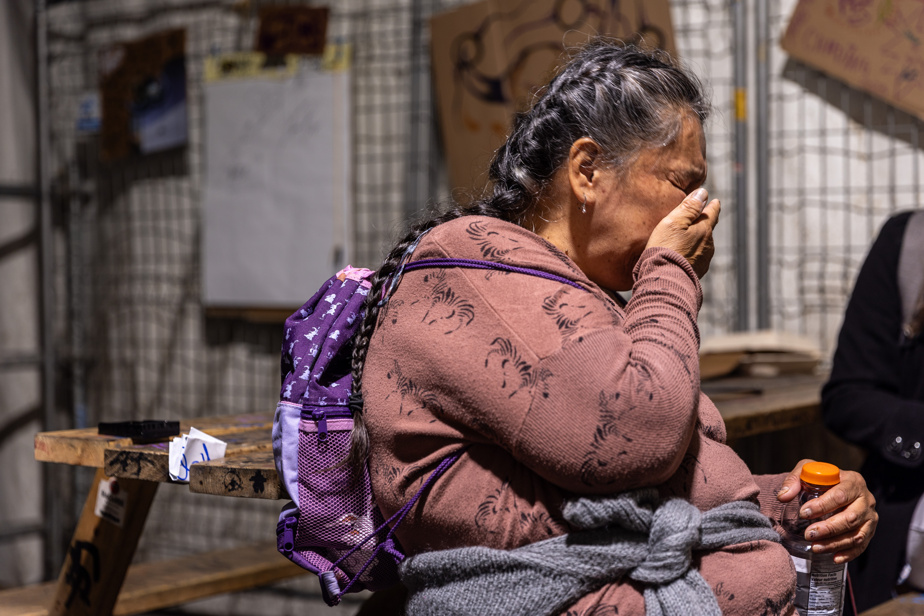At the corner of Saint-Dominique and Ontario streets, in the heart of downtown Montreal, the indigenous community is struggling to recover from the death of Sindy Wabanonik. The mother succumbed to the wave of overdoses which affected nine people there last Sunday, leaving a gaping wound behind her.
“It hits me, it shakes me,” murmurs Jean-Cloudy, who, like Sindy Wabanonik, comes from the Anishnabe community of Lac-Simon, in Abitibi-Témiscamingue. This Thursday evening, installed in the tent of the organization Projets Autochtones du Québec (PAQ), rue Saint-Dominique in Montreal, he decorated a card in memory of Sindy. “Love you my friend”, we can read in the middle of golden hearts.

PHOTO JOSIE DESMARAIS, THE PRESS
Jean-Cloudy decorates a card in memory of Sindy.
Talking about her upsets him. His throat tightens. His neighbor at the table hugs him. A little further on, Madeleine Shecapio is sobbing.
Sindy was my best friend. I miss her so much.
Madeleine Shecapio
Both in the surrounding streets and in this shelter for homeless Aboriginal people, tensions are high. Last Sunday, nine people had to be taken to hospital after consuming contaminated drugs, creating a shock wave. Sindy Wabanonik, a 42-year-old mother and pillar of the community, did not survive.
Shock
PAQ organization worker Nicole Meecham, in office for only a month, was the first on the front line.

PHOTO JOSIE DESMARAIS, THE PRESS
Nicole Meecham, speaker from the organization Projets Autochtones du Québec
A community member came to tell us that there was a group of people overdosing further down the street.
Nicole Meecham, speaker from the organization Projets Autochtones du Québec
Grabbing naloxone – the medication that can reverse the effects of an opioid overdose – she rushed off with a security guard. They found six people in respiratory arrest.

PHOTO JOSIE DESMARAIS, THE PRESS
Naloxone can reverse the effects of an opioid overdose and save lives.
“It was shocking to see so many people overdosing at the same time,” says M.me Meecham. “We administered naloxone, as many doses as we had on us, and the emergency services arrived really quickly,” she describes.
Days later, the scene still haunts him. “Yes, we are trained for that,” she emphasizes, “but we don’t know what it is until we experience it. »
Wear his heart on his sleeve
“Sindy was very lively, very funny. He was the type of person who made everyone laugh,” recalls Mme Meecham. “She was also part of the indigenous community of Montreal for a long time, and many people feel her loss. »

PHOTO FROM SINDY WABANONIK’S FACEBOOK PAGE
Sindy Wabanonik
Mother of three children living in Abitibi-Témiscamingue, Sindy Wabanonik commuted between Montreal and her birthplace. His brother, Lucien Wabanonik, is chief of the Lac-Simon community.
The death of his little sister, the “baby of the family”, affects him deeply.

PHOTO OLIVIER JEAN, LA PRESSE ARCHIVES
Lucien Wabanonik, brother of Sindy Wabanonik, is chief of the community of Lac-Simon, in Abitibi-Témiscamingue.
She was a good person, helpful, smiling, with an open mind. […] She loved her freedom, she wanted to help in her own way.
Lucien Wabanonik, brother of Sindy
When Lucien Wabanonik learned that Sindy was in intensive care at the beginning of the week, he did not hesitate for a second: he gathered the family and took the long road to Montreal.
He didn’t expect to find Sindy unconscious, having suffered significant brain damage after her overdose. He also didn’t expect the outpouring of support and hospital visits. Members of the Montreal indigenous community who brought cards, testifying to the help Sindy had offered them.
“They spoke highly of her to us,” says Mr. Wabanonik. She helped them with the translation [Sindy parlait plusieurs langues], writing, looking for accommodation, work, giving numbers, contacts. »

PHOTO PROVIDED BY PROJECTS INDIGENOUS DU QUÉBEC
Memorial in memory of Sindy Wabanonik, last Wednesday
The loss is all the greater because, to Mr. Wabanonik’s knowledge, Sindy was doing better in her fight against addiction.
“I saw her not long ago in Montreal, when I was on a business trip,” he remembers. I knew she was coping, she was doing great. She was on the right track. »
Anger and incomprehension
Through the mourning, anger is also brewing in the city center. “Before COVID-19, it wasn’t like that at the corner of Saint-Laurent and Ontario,” denounces Robin, a resident of the PAQ shelter who did not want to give his full name. “The police pass by, they see the drug dealers and they do nothing! »

PHOTO JOSIE DESMARAIS, THE PRESS
The Projets Autochtones du Québec shelter for indigenous homeless people is located in the Hôtel des Arts.
The contaminated drug was sold by a person “who is not part of the indigenous community, but whom everyone knows,” also specifies Nicole Meecham.
In 2017, a series of overdoses linked to fentanyl led to an investigation by the Montreal Police Service (SPVM) called Project Asterios. In 2020, four men and one woman were convicted in connection with this case.
For Lucien Wabanonik, the ease of obtaining drugs in Montreal is “shocking” and the help to combat addiction is insufficient. Not to mention the racism faced by members of the First Nations. According to him, “we need collaboration and concrete actions to help our people, who need it. A lot “.
The story so far
September 10
Nine people, including seven homeless Indigenous people, are transported to hospital for overdoses that could be linked to fentanyl in Montreal.
September 11th
The Montreal Regional Public Health Department (DRSP) is launching an investigation “in order to identify the circumstances of these overdoses and determine with the community the awareness-raising interventions to be enhanced”.
September 12
Sindy Wabanonik died as a result of her overdose, but the information was not publicly confirmed by the SPVM until September 14.
September 13
A vigil in memory of Sindy Wabanonik is being held at the location where the series of overdoses took place, rue Saint-Dominique.
